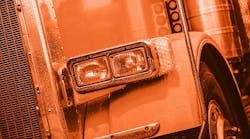Diesel engine displacement has become one of the most hotly debated topics in the trucking industry. While some predict the demise of the 15 to 16L big bore engine, and others insist that there's "no replacement for displacement," the future for engine displacement in the industry seems to lie somewhere between these two thoughts.
Currently, the trucking industry favors two displacement ranges:
- The 15 to 16L range, which is well-suited for long-haul trucking operations, as well as heavy-haul operations.
- The 12 to 13L range, an ideal fit for the needs of regional hauling and LTL (less-than-truckload) distribution operations, as well as vocational applications like dumps and mixer trucks and fire and emergency vehicles.
Each displacement range has unique characteristics that must be evaluated against needs in order to determine which best fits. Demand from fleets and owner operators for engines that meet their specific needs will continue to drive the engine displacement options offered by engine and truck manufacturers.
Reliability and Durability
When determining appropriate displacement for their operation, fleets and owner operators should first consider the power and torque necessary to meet their needs. Generally speaking, the amount of horsepower and torque that an engine can provide increases with engine displacement.
However, the high end of the 12 to 13L power range may overlap with the low end of the 15 to 16L range. In these instances, it is important to understand that, at the same rated power, a larger displacement engine will inherently offer increased reliability and durability.
Reliability and durability are also key to helping fleets or owner operators decide on engine displacement.
Larger Displacement Engines
An engine, like engines in the 15 to 16L range, are designed to run as high as 600 hp, but typically run at or near 450 hp. These engines deal with less load than 12 to 13L engines running at their maximum horsepower.
Lower load means less work for the engine, which in turn results in longer engine life.
Larger displacement engines also have more braking horsepower from the engine brake, resulting in reduced service brake wear. Because they're more durable, larger displacement engines also offer owners higher resale value than their smaller displacement counterparts.
Lower Power Density
Because they operate at a lower power density than smaller displacement engines at the same rated power, 15 to 16L engines have increased capacity and margin relative to cylinder pressure capability and mechanical and thermal limits.
Additionally, lower power density may enable a more simple engine platform, or may provide the flexibility to optimize the engine and sub-systems to achieve the best blend of desired performance, fuel economy and emissions characteristics.
On the other hand, in some applications it may be more important to have the compact size, lighter weight and high power-to-weight ratio offered by engines in the 12 to 13L range.
Overall, a larger displacement engine is likely to be more adaptable to a fleet's or owner operator's needs. Because they're able to offer a more broad range of horsepower and torque ratings, the 15 to 16L engines are more adaptable to different applications.
Difficult to Equate
Some may argue that smaller displacement engines offer better fuel economy than larger engines. However, it's not entirely possible to directly equate fuel economy and displacement. Many factors, such as bore and stroke optimization, valve size, turbo efficiency and the ability to downspeed an engine, play a role in fuel economy.
In addition to these engine related fuel economy influencers, it's important to remember that the driver can have up to a 30 percent impact on fuel economy, so factors like engine performance and driveability are also important to consider. Experienced drivers will be able to feel the difference between a 15 to 16L engine throughout the entire power range, and they'll benefit from stronger clutch engagement as well.
Overall Power Needs
The debate on engine displacement will continue as trucks and engines continue to evolve to meet changes in regulations. Greenhouse gas emissions standards are pushing both truck and engine manufacturers to develop products that use less fuel.
Vehicle improvements are likely to reduce the overall power the engine needs to provide, but engine technology selection will continue to influence optimal displacement.





